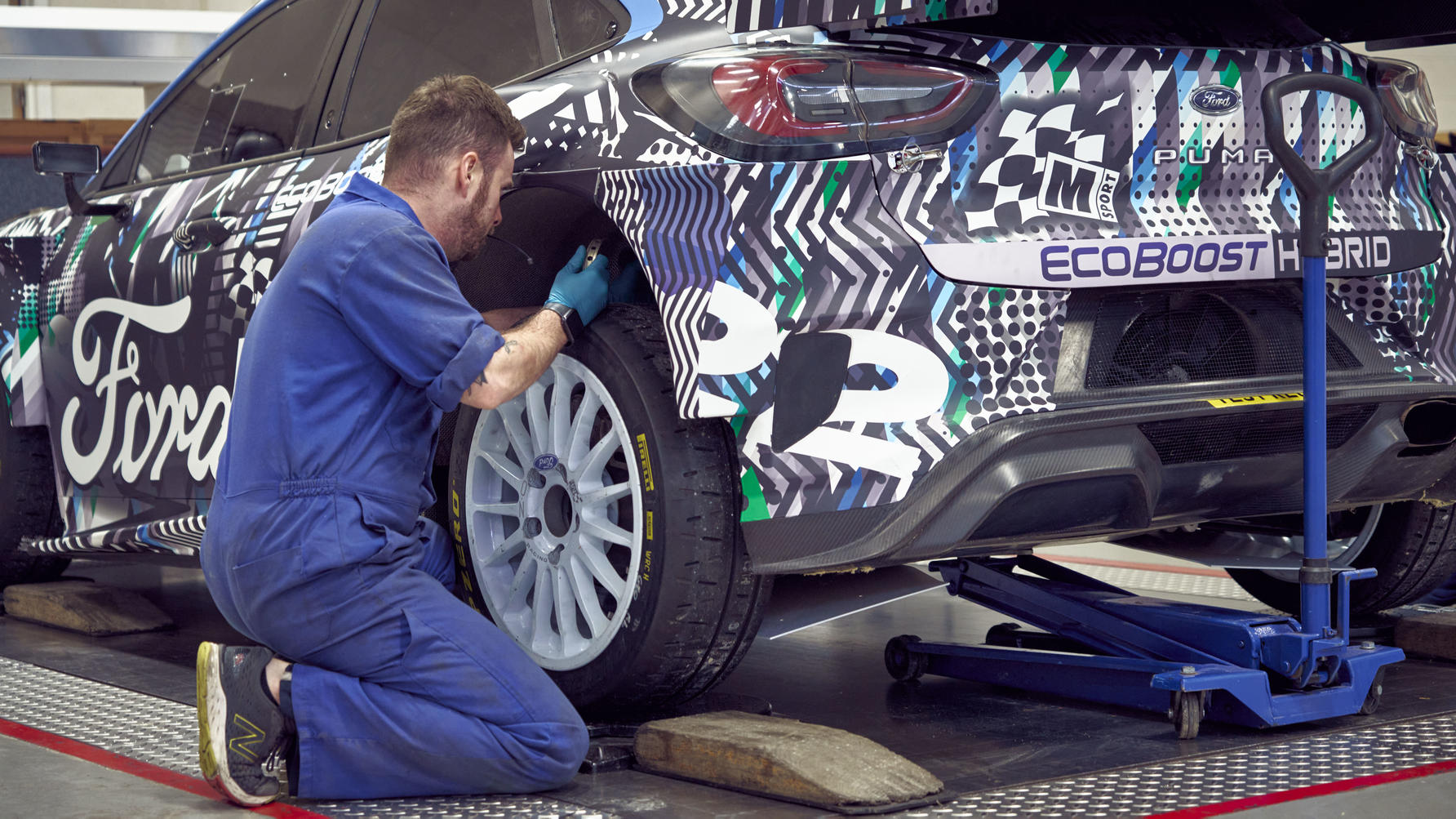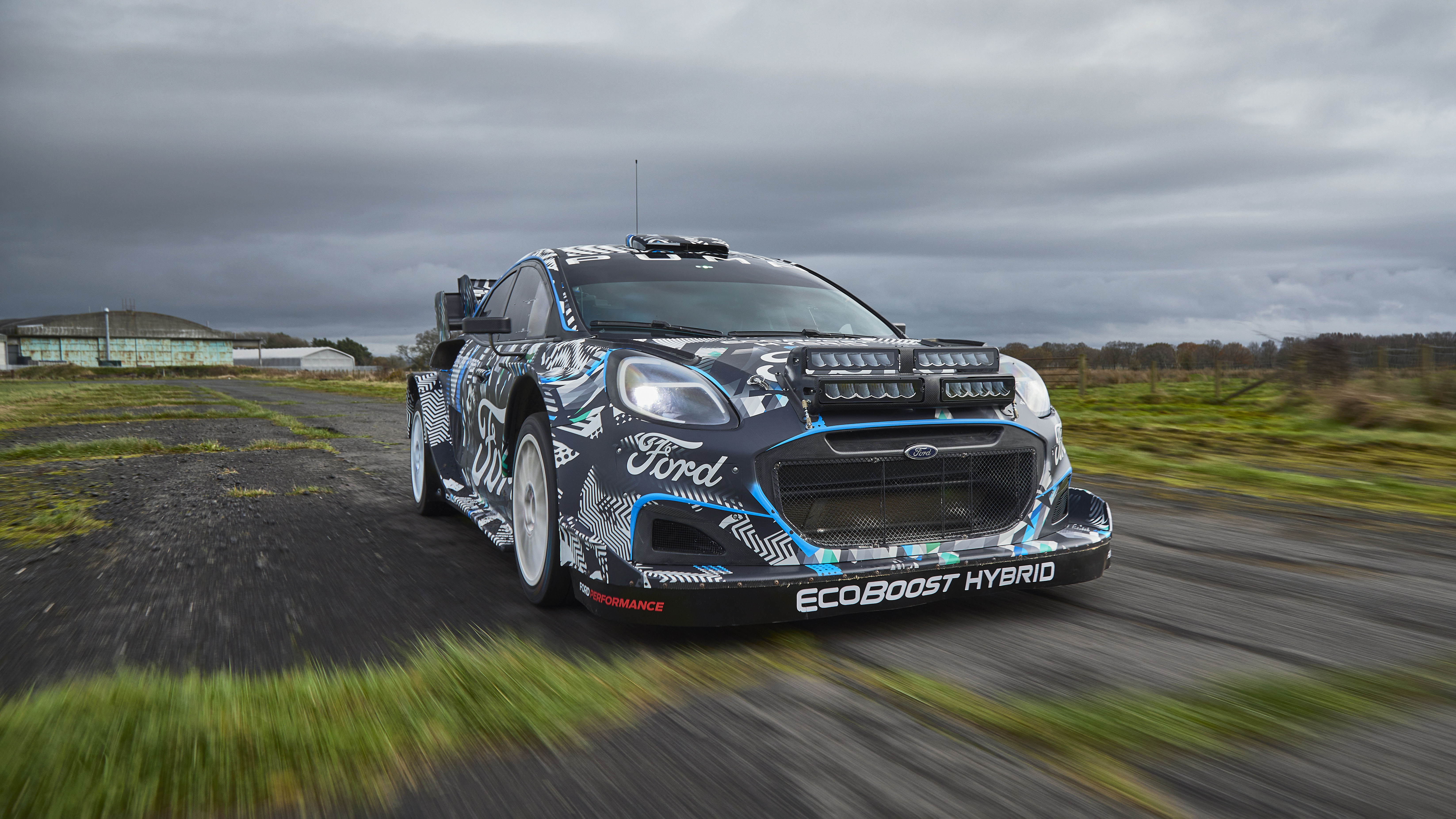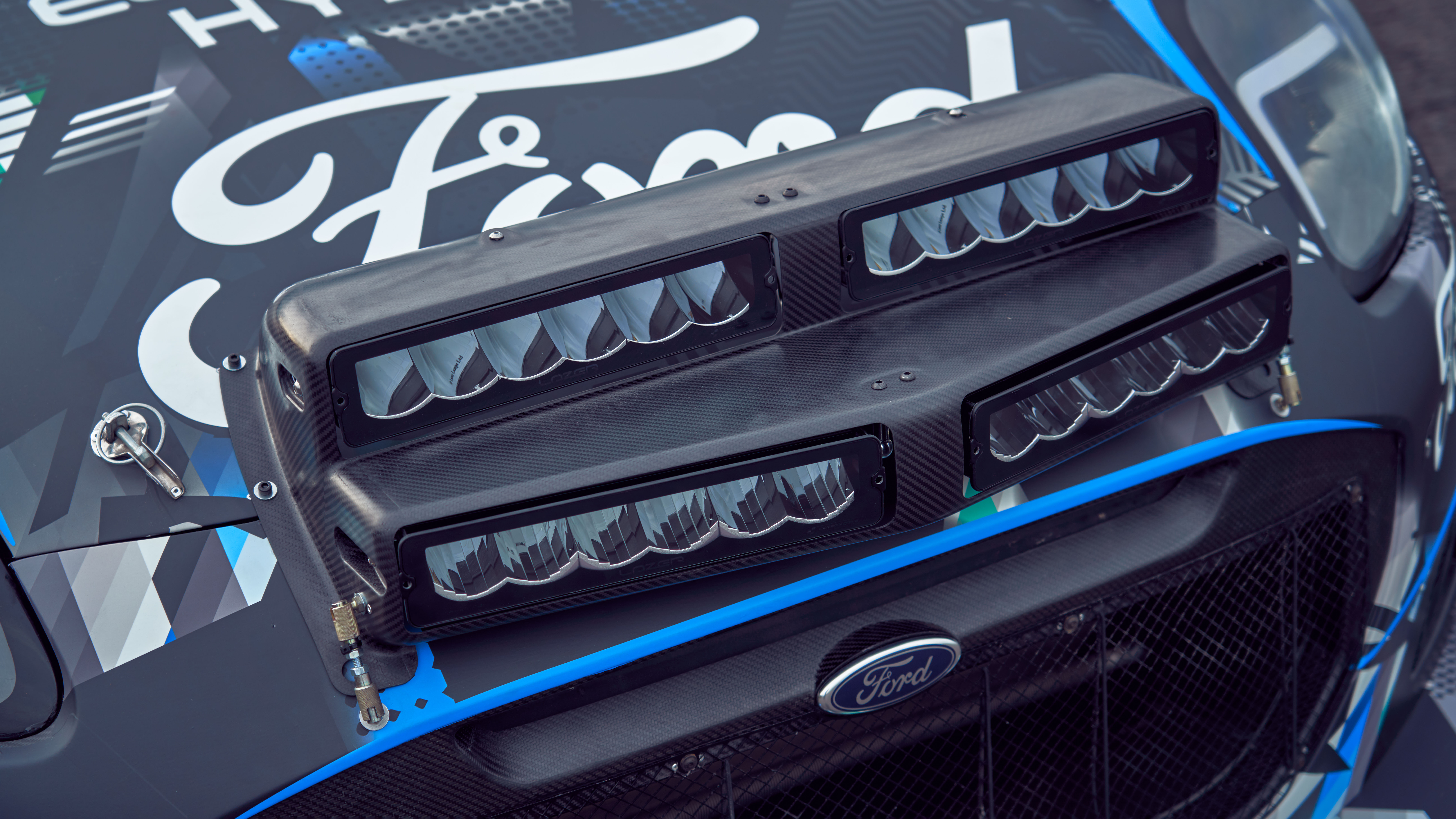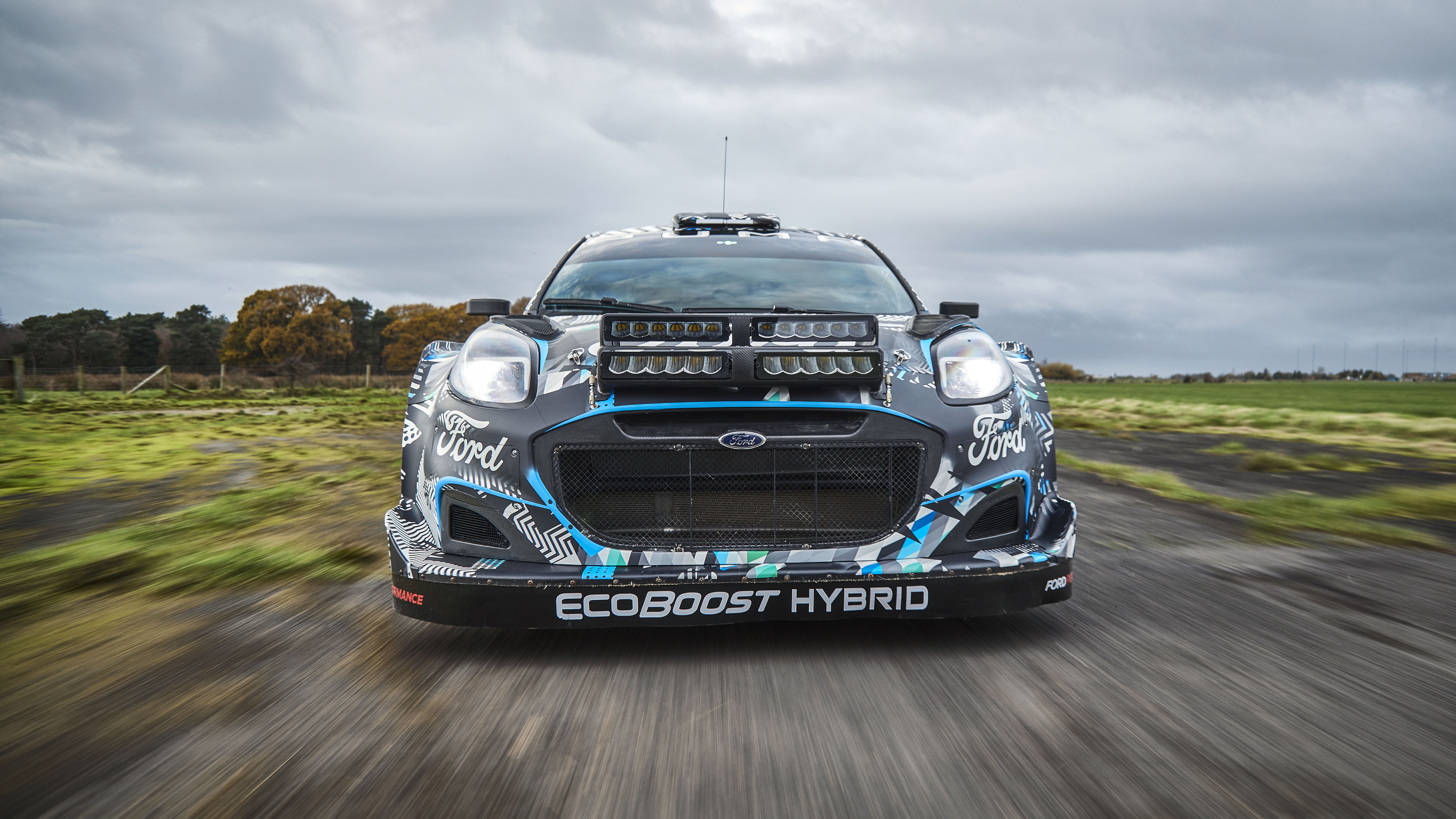
A closer look at Ford's new hybrid Puma WRC racer
It's the first appearance of electrification in top-flight rallying, and it’s going to cause a stir
“This is an entirely different thing. It’ll take a switched-on crew to get something out of that.” Sage words from a man who knows his mud-flapped onions. David Lindsay has spent the last two decades shaking down M-Sport’s, and thus Ford’s, World Rally Championship competitors. From the Focus WRC made famous by McRae to the outgoing Fiesta WRC that took title honours with Ogier – and everything in between – he’s driven it. If anyone can deliver a succinct vox-pop on how the new, hybrid powered Ford Puma WRC feels, David’s yer man.
The 2022 season brings a number of big regulation changes, and the growth from Fiesta to Puma visualises them nicely. As well as being safer, the cars are bigger, with another 107mm in their FIA-regulated wheelbase and an additional 70 kilos of timber. Or rather batteries. This is the first appearance of electrification in top-flight rallying, and it’s going to cause a stir.
Photography: John Wycherley
The Puma’s mechanical core isn’t far off the Fiesta it replaces. A 1.6-litre four-cylinder engine continues to drive all four wheels through a five-speed sequential gearbox, with peak output of around 400bhp. What’s most obviously new is the addition of another 134bhp in hybrid boost, vastly raising the power-to-weight ratio… sometimes.
And it’s the same for all cars; the battery pack arrives sealed up from Compact Dynamics and is placed in a location chosen by the FIA to both maximise safety and create some parity in the weight distribution of Ford, Hyundai and Toyota’s Rally1-class contenders.
But neither the Puma nor its i20 and Yaris rivals will be 500-odd horsepower cars for long. On the start line, drivers will be allowed full power for their first acceleration, lasting around three seconds. Which is basically the car’s 0-62mph time. Then it’s back down to petrol power only until the driver earns what’s called a ‘valid regen’. Basically, they have to brake hard enough and long enough to satisfy a set of criteria and unlock a 30 per cent boost which might already be sitting there untapped.
“It’s not like the endurance side of things; hybrid isn’t something that’s been slowly coming in for the past couple of years,” says Craig Breen, who’s moved from Hyundai to lead M-Sport’s assault on the championship. “It’s the first exposure we’ve got to it so we’ve got a lot of things to learn. It’s definitely taken me a little bit of time to get myself up to speed.”

Will drivers be braking in corners they might usually take flat? “There’s definitely a bit of adaptation that needs to be done,” says Breen. “It’s a trade-off; we want to unlock as many boosts as we can but obviously every time you’re braking. you’re slowing the car down.
“So you need to be realistic about where you’re genuinely better off braking a bit more, and getting the boost, and where you’re better off not worrying about it and just carrying the speed. It’s going to take over rallies in the coming years and it might be a couple of seasons before people really get to grips with it.”
It’s hard to imagine some of the most committed rally drivers of yore – a certain Scotsman, whose pictures decorate the halls of M-Sport’s Lake District base, comes to mind – being altogether cool with deliberately hard braking where it’s not needed, merely for a brisk electric boost onto the next straight. Mind, braking hard into a corner before exiting with a whole heap of extra power may make for some extraordinarily slapstick action.
Which leads us onto the new safety aspect. The outgoing Fiesta WRC was exactly that – a production Fiesta shell given a motorsport makeover. The core of all new Rally1 cars is a steel spaceframe chassis that follows strict regulations with some bespoke panels (a number of them carbon) bonded to it. Side-impact protection has been the big focus, and some high-speed shunts in testing – involving the Puma’s rivals – have already given the new spaceframe a stern test. While some of the cage’s angles are dictated by the FIA, M-Sport promises you’d be able to tell Rally1’s three gladiators apart in their barest form.
Up top, though, you’re looking at a much racier Puma than you’ll find on the streets, one that’s got three doors and a slenderer aesthetic not unlike seeing your mate a few weeks after they’ve tried a fad diet. Or been ravaged by a particularly relentless stomach flu. It sits much lower to the ground than its road-going cousin and appears to have had heft liposuctioned out of it, though it may be a trick of its bespoke proportions. I suggest this is a prime basis for a road-going Puma RS – with the 534bhp output intact, obvs – and get a bunch of smirks and ‘if onlys’ in return.
To be fair, this would be a lot of performance on road. My stint in the co-driver’s seat amounts to a couple of minutes at Kirkbride Airfield, but never has so little time in a car provided such a vivid and lasting impression of what it can do. You want a cut-price set that mimics loose-surface motorsport? An autumnal Cumbrian airstrip does a fair old impression of that.
Top Gear
Newsletter
Thank you for subscribing to our newsletter. Look out for your regular round-up of news, reviews and offers in your inbox.
Get all the latest news, reviews and exclusives, direct to your inbox.
And yet David makes the Puma look effortlessly precise, with balletic handbrake turns the cherry on top of his stupendously hard braking after a number of repeated zero-to-130mph (ish) runs. The Puma’s at once gobsmacking and unflustered, remarkable and yet not. The modern rally car is the true swan of motorsport, expensive diffs and damping lending the driver’s quarters an air of utter calm.
But holy cow it’s fast. Those three seconds of full boost are a proper rocket up the bum, and with five short, sharp gears, we seem to nudge our estimated top speed in barely a heartbeat. And all while gliding luxuriantly over grimy, pockmarked surfaces that’d nearly shaken the door cards from my Hyundai road car on the way in to our rendezvous.
I can’t comment on the improved safety of 2022’s top-flight rally cars because David’s a gent and didn’t crash. Is hybrid technology as an occasional booster anything other than a gimmick for commentators to get their tongues twisted over? That’s up for debate. In time, we might see cars whirr silently around the service area, or travel between stages using electric power only to spin some positive local PR. As for performance, the extra power has made a brief but ballistic impression on my proudly bobble-hatted head. Seeing just how many drivers opt to use the boost at every opportunity – and how many swerve the brake pedal and just stick to last year’s pace notes – will be the real adjudicator of how fruitful the electrification of WRC has been.
“Some drivers might still try to drive their own way,” says M-Sport development boss Tim Jackson. “But ultimately they won’t win. The ones that can adapt to the challenge with an open mind, not stuck in their ways, will be the ones with the rewards at the end of the season.”
Trending this week
- Car Review
BMW 1 Series











